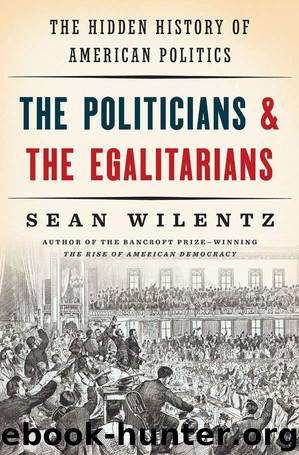The Politicians and the Egalitarians: The Hidden History of American Politics by Sean Wilentz

Author:Sean Wilentz [Wilentz, Sean]
Language: eng
Format: epub
Publisher: W. W. Norton & Company
Published: 2016-05-17T06:00:00+00:00
FOR MANY YEARS, the literary scholar Henry Louis Gates, Jr., has been vigorously expanding and institutionalizing the study of African American literature and history, bringing to light forgotten but important writings by black authors, and serving as a link between the academy and an American mass audience. For the book Lincoln on Race & Slavery, Gates and his coeditor, Donald Yacovone, chose seventy writings by Lincoln and reprinted either key passages or the entire document, along with commentary and an extensive introduction by Gates. Originally published in connection with a PBS documentary, the book dwells on what Gates contends was Lincoln’s supposedly imperfect stance on slavery and his even more imperfect stance on race.
In his introductory essay, Gates reports that he is especially struck by how Lincoln developed quite distinct lines of thinking about the two subjects—as well as about a third subject, colonization: the idea that blacks, once emancipated, ought to resettle voluntarily in Africa or in some other tropical destination far from the United States. Much of his discussion of these matters ably summarizes what historians have been saying over the last forty years.
The basic historical connections between slavery and racism before the Civil War are straightforward. Essentially, white Americans divided into four groups. Virtually all proslavery Americans believed absolutely in white supremacy, and thought that inferior blacks merited bondage. All Americans who believed in racial equality were adamantly antislavery. Most antislavery American whites believed, to one degree or another, that blacks were inferior. A fourth group, identified with Stephen A. Douglas and the Northern Democratic Party, expressed moral indifference to slavery and were firm white supremacists.
The first of these groups, the proslavery forces, dominated the South. The second group, the immediatist abolitionist radicals, represented a small minority in the North, and believed that slavery should be abolished immediately throughout the entire country. The third, the non-immediate antislavery forces, represented, by 1860, a majority of the North, and included a wide spectrum of views about race.
The most conservative of this third group were vicious racists who wanted to halt slavery’s expansion in order to keep the western territories lily white. At the liberal end were those, like Lincoln, who believed that blacks, although inferior to whites, were human beings endowed with rights and should be emancipated. Antislavery Northerners, whatever their view of blacks, wanted to end slavery, but, unlike the immediatist abolitionists, they believed they could do it under the U.S. Constitution, despite the Constitution’s protections for slavery where it already existed. As an important first step toward eliminating slavery nationwide, they fought for a congressional prohibition on the expansion of slavery into the territories, which they believed (and the proslavery forces denied) the Constitution allowed. Lincoln, after 1854, became a preeminent political leader of this broad antislavery group, with views on race that were decidedly at the more liberal end.
The colonization idea attracted some slaveholders in the upper South and, for a time, a few black activists in the North, as well as some non-abolitionist but antislavery white Northerners.
Download
This site does not store any files on its server. We only index and link to content provided by other sites. Please contact the content providers to delete copyright contents if any and email us, we'll remove relevant links or contents immediately.
The Secret History by Donna Tartt(16621)
The Social Justice Warrior Handbook by Lisa De Pasquale(11489)
Thirteen Reasons Why by Jay Asher(7788)
This Is How You Lose Her by Junot Diaz(5769)
Weapons of Math Destruction by Cathy O'Neil(5036)
Zero to One by Peter Thiel(4824)
The Myth of the Strong Leader by Archie Brown(4789)
Promise Me, Dad by Joe Biden(4447)
Beartown by Fredrik Backman(4415)
Stone's Rules by Roger Stone(4415)
How Democracies Die by Steven Levitsky & Daniel Ziblatt(4398)
The Fire Next Time by James Baldwin(4342)
100 Deadly Skills by Clint Emerson(4076)
A Higher Loyalty: Truth, Lies, and Leadership by James Comey(4032)
Rise and Kill First by Ronen Bergman(4012)
The David Icke Guide to the Global Conspiracy (and how to end it) by David Icke(3881)
The Farm by Tom Rob Smith(3872)
Secrecy World by Jake Bernstein(3782)
The Doomsday Machine by Daniel Ellsberg(3730)
